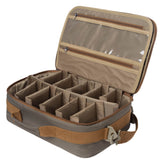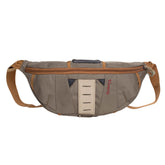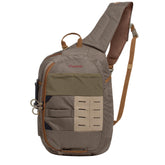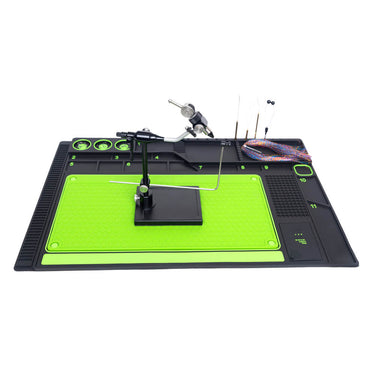Flies: An Essential Guide to the Best Types for Beginners and Hand-Tied Options
When it comes to fly fishing, selecting the right fishing flies can significantly enhance your experience on the water. Understanding the different types of fishing flies, including dry flies, nymphs, and streamers, is crucial for targeting specific fish species effectively. As I have learned through experience, knowing these variations allows me to adapt my approach based on the conditions and preferences of the fish I am trying to catch.

For beginners, choosing the best fishing flies might seem overwhelming, but starting with a few versatile hand-tied options can make all the difference. These artificial flies often mimic the local insect life and can be key in attracting fish during a trip. I have found that investing time in learning about various fly patterns not only improves my skills but also makes the process more enjoyable.
Whether you're just starting or have some experience, exploring the world of fishing flies opens up endless opportunities for success. Having a solid understanding of the types of flies available can elevate your fly fishing adventures and lead to more productive days on the water.
Fundamentals of Fly Fishing
Fly fishing combines technique and knowledge to enhance the fishing experience. Understanding the fundamental aspects, such as effective fly fishing techniques and the different types of flies, significantly improves success rates on the water.
Fly Fishing Techniques
Effective fly fishing requires the right techniques to present the fly naturally. I often start with casting techniques, which include the overhead cast, roll cast, and sidearm cast. Each technique has its unique application, depending on wind conditions and surroundings.
It's essential to adapt your presentation based on the species being targeted. For instance, when targeting trout in freshwater, I focus on precision and delicacy, while fishing for bass might require a more aggressive approach.
Retrieval methods are also crucial. I vary the speed and movement, sometimes using a steady strip or an erratic retrieve to imitate fleeing prey. Matching the conditions and the behavior of fish leads to a more productive fishing session.
Understanding Flies
A comprehensive knowledge of flies can significantly influence my success in fly fishing. Flies are categorized mainly into three types: dry flies, nymphs, and streamers. Each serves a specific purpose and matches particular feeding patterns of fish.
Dry flies float on the water's surface, enticing fish that are rising to feed. Nymphs sink below the surface, mimicking the larvae of aquatic insects. Streamers represent baitfish or other larger prey, often used for aggressive species like bass.
I keep an organized fly box, stocked with various patterns tailored for specific conditions. Additionally, understanding the concept of "match the hatch" allows me to choose the right fly according to the insects present in the environment. By focusing on these elements, I enhance my effectiveness in both freshwater and saltwater fishing.
Types and Selection of Fishing Flies
Understanding the various types of fishing flies and how to select the right one is essential for successful fishing. Different flies target specific fish species and imitate various aquatic insects.
Popular Types of Flies
There are several popular types of fishing flies, each designed to mimic specific food sources for fish. I often use the following categories:
- Dry Flies: These float on the water's surface, mimicking insects like mayflies and caddisflies.
- Nymphs: Subsurface flies that imitate juvenile aquatic insects. The pheasant tail nymph is a favorite due to its effectiveness.
- Streamers: Larger flies that mimic baitfish or larger insects. They work well for predatory fish species.
- Soft Hackle Flies: A versatile option that creates movement in the water, attracting fish.
Each of these types has its unique patterns that can be quite effective depending on the situation.
Choosing the Right Fly
Selecting the right fly depends on various factors. I consider the following:
-
Match the Hatch: Observing what insects are present can guide fly selection. If mayflies are hatching, using a corresponding dry fly is advisable.
-
Fish Species: Different fish prefer specific flies. For trout, I often employ both dry and nymph patterns, while bass might respond better to streamers.
-
Environmental Conditions: Water temperature and clarity affect fly choice. In murky water, I might opt for more colorful attractor patterns to catch attention.
Considering the hardiness of materials and the fishing environment can also influence my decision. Successful fishing requires attention to detail and adapting to conditions.
Starting with Fly Fishing
Embarking on a fly fishing journey requires familiarity with essential techniques and gear. I will outline key aspects that make the experience enjoyable and successful.
Guidelines for Beginners
I recommend starting with the basics of casting and understanding your target species, such as trout or bass. Learning to read water helps identify the best spots for fishing, especially in small streams, lakes, and ponds.
I also suggest practicing different casting styles: roll casts, sidearm casts, and overhead casts. Each technique proves useful in varied environments. When selecting fishing flies, hand-tied options allow for customization based on local conditions.
Additionally, I encourage beginners to seek advice from local anglers. Observing how experienced fishermen approach fly fishing can offer valuable insights. Joining workshops or guided trips can also enhance skills and tackle techniques efficiently.
Essential Fly Fishing Gear
Choosing the right gear is critical for a successful outing. I prioritize a good quality fly rod that suits my chosen fishing environment. For most beginners, a 9-foot, 5-weight rod works well in various conditions, including rivers and lakes.
In addition to the rod, I ensure I have an appropriate fly reel. Opting for a reel with a reliable drag system is important for handling larger fish like steelhead or bass.
I also keep a well-stocked fly box. My selection includes nymphs, dries, and streamers tailored for local species. Lastly, don’t overlook essential accessories, such as waders, leaders, and tippet material, as they significantly improve the fishing experience.
Hand-Tied Flies and Their Advantages

Hand-tied fishing flies are an essential part of fly fishing for trout and salmon. They provide versatility and customization that mass-produced flies often cannot match. Crafting these flies allows me to adapt to various water conditions and target specific species effectively.
Crafting Custom Flies
When I craft custom flies, I focus on replicating the natural diet of the fish I am targeting, such as bait fish or crustaceans. By choosing specific fly patterns and variations, I can match the visibility and movement in the water.
Using high-quality materials like hackle enhances the fly's realism, helping to attract fish more effectively. For instance, I may use brightly colored feathers for visibility or opt for muted tones that mimic natural prey. This custom approach allows me to create a unique fly tailored to my fishing environment.
Benefits of Hand-Tied Flies
Hand-tied flies offer several advantages over store-bought options. First, they allow me to control the materials and techniques used, ensuring a higher quality fly. This personalized touch can lead to a more successful fishing experience, particularly in areas where salmon and trout are prevalent.
Moreover, hand-tied flies can be more effective due to their unique characteristics. I can adjust weight, size, and shape to suit different freshwater streamers and conditions. Additionally, I find that my hand-tied creations often feature more durable materials, increasing their lifespan on the water. Each fly becomes a reflection of my skill and understanding of the fish behavior, ultimately enhancing my overall fishing success.















